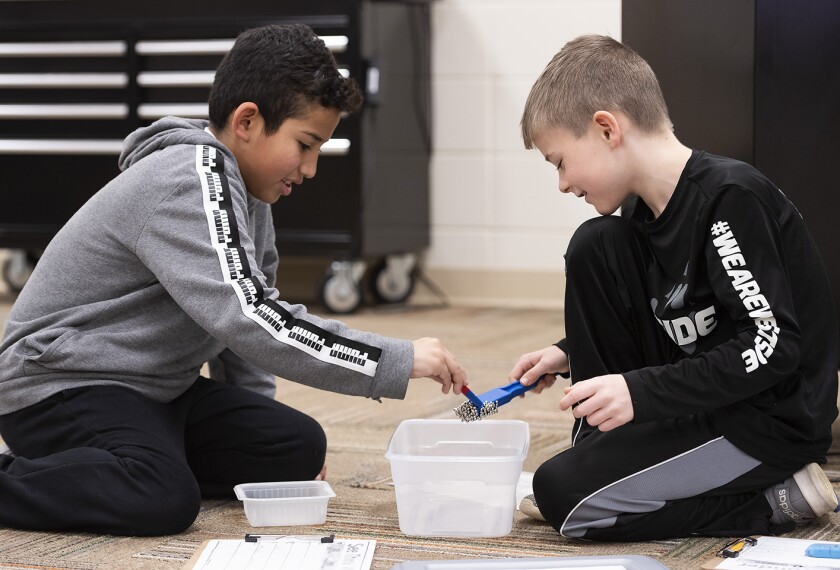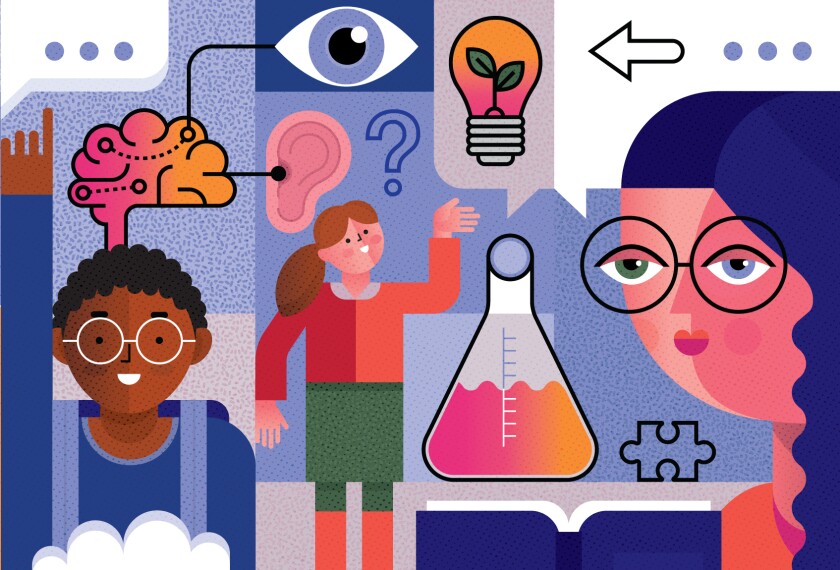Teaching elementary school science can be a struggle.
Math and English dominate the schedule in the early grades, often leaving scant time for science. And most elementary teachers don’t have a science background, meaning that there can be a steep learning curve for educators who want to dive deep into science topics.
Another hurdle: finding materials that account for these challenges—all while aligning to state standards.
“A lot of teachers here in our public schools feel like they have to create everything from scratch,” said Jennifer Williams, the department chair for lower school science at the Isidore Newman School, a private, independent school in New Orleans.
An upcoming curriculum project is aiming to fill that gap.
OpenSciEd, an initiative to provide free, open-source instructional materials aligned to the Next Generation Science Standards, is starting to develop elementary units to complement its growing stable of middle school lessons. The group plans to begin releasing the units over the next few years.
Developed by a collaborative of states and science education organizations, the Next Generation Science Standards, or NGSS, were released in 2014. Since then, 20 states and the District of Columbia have adopted them, and 24 states have developed their own standards based on this framework.
But elementary materials are still “catching up” to these new standards, according to a recent report on the state of the field from the National Academies of Sciences, Engineering, and Medicine. Organizations that review curricula for alignment and ease of use have given strong ratings to just a handful of products.
In part, this lag between the standards and materials development has to do with how different the NGSS are from the way science was taught in the past, said Vanessa Wolbrink, the associate project director for NextGenScience, a team at the research and consulting organization WestEd that supports implementation of the standards in districts.
“You might think you have to remodel your house. But you have to knock down that house and rebuild it,” she said.
Amid big instructional shifts like this, free curricula can play a big role.
For example: When the Common Core State Standards first came out in the early 2010s, New York State developed EngageNY, a resource library of aligned materials that teachers could download. Within its first few years, the content had been downloaded more than 20 million times by educators in other states around the country.
How NGSS are different than previous ways of teaching science
The Next Generation Science Standards aim to turn science into something that children do, rather than a class where they only learn about what others have done, said Brian Reiser, a professor of learning sciences in the School of Education and Social Policy at Northwestern University. The goal is to make science feel connected to students’ lives, he said.
Reiser, whose team at Northwestern is leading a group of developers creating the OpenSciEd elementary units, also helped develop the science framework that guides the NGSS.
A hallmark of the new standards is student inquiry. Lessons and units are designed around phenomena—observable events like hurricanes or climate change—that students then work to explain through science principles. At the same time, they’re learning how to employ the practices that scientists and engineers use in their work.
“With the new way that we are teaching science under NGSS and with sense-making, we have to release control,” said Williams, the science department chair in New Orleans. “That is a total mindshift for our more veteran teachers.”
This challenge of pedagogy exists at all grade levels, but there are also unique barriers elementary teachers face in aligning their instruction to the new standards.
As Education Week has reported, elementary school teachers often don’t have extensive science backgrounds. Most preparation programs for those teachers don’t require coursework in biology, chemistry, or physics.
Elementary students are also at a different place in their cognitive development than older kids. A 5th grader might be able to evaluate their understanding of a “phenomenon,” and then think about what they still need to know. But that process might need to be simplified for a 1st grader, said James Ryan, the executive director of OpenSciEd.
“Some of the routines that we have built into the middle and high school materials will have to be adjusted,” he said.
Finally, there’s the obstacle of time: Science often gets short shrift in elementary school classrooms, edged out by math and reading—subjects that are the focus of mandatory testing. Only once a school has high test scores in math and English/language arts, it “feels comfortable in making time for science,” Ryan said.
“If a school struggles and doesn’t test well, they double down and put more time in those subjects—and they do so by abandoning science instruction,” he continued. “And what that looks like is a very inequitable system.”
Developing ‘creative’ ways to fit science into the school day
The OpenSciEd developer team is trying to address these roadblocks. For one thing, the units will be designed to help schools get “creative” about fitting science into the schedule, said Amelia Gotwals, an associate professor of science education at Michigan State University, and a member of the developer team.
“We’ve thought about lessons as being in components, or in sections, that you can split up to be in different times during the school day,” she said. Some elementary schools have a science block every other day; others alternate weeks of science and social studies time. “We’re trying to create the curriculum to be usable for all of those different models,” shes said.
The materials will also integrate numeracy and literacy skills, so that they touch on math and ELA standards, as well as science ones. “We’ve found it really helpful for administrators that we can point [that] out,” Gotwals said. For example, a text set that helps students make sense of a scientific phenomenon could be used as part of a read-aloud block.
Incorporating more science and social studies into reading periods is an idea that’s gained traction in the ELA community, too, among advocates of “knowledge-building curricula.” Studies have shown that building students’ background knowledge, including key science content like biology and earth science, can help their reading comprehension when they encounter those topics in other texts.
Including science read-alouds is one way to build more science time into the day. But Gotwals and Reiser both emphasized that it shouldn’t be the only time students get with the subject.
Instead, text should serve as a way that students can seek the answers to questions they come up with, Reiser said.
How might an elementary lesson be structured?
Take a 4th grade lesson about how water waves work. The teacher wouldn’t start by describing a model. Instead, Reiser said, a teacher might open the lesson like this: “We’re going to start that unit with an interesting story, about people who found thousands of Dorito chip bags washing up on the beach.”
Why—and how—did that happen?
“That conversation surfaces lots and lots of questions,” Reiser said. To answer some of those questions, students might read a passage about how storms affect wave patterns. The reading serves a specific purpose.
“We’re not doing it because it’s reading time; we’re not doing it because it’s [about] waves. We’re doing it because we have all of these questions,” Reiser said.
How students record their findings and keep track of evidence will look different for the youngest learners, too, said Gotwals. “With our older students, we often can use print words to help them in their thinking about their thinking,” she said.
Kids might keep track of their wonderings on a board of ongoing questions throughout a unit, she said. For students who can’t yet read fluently, the team is coming up with other ways to serve that same purpose.
The development of the OpenSciEd units is on a multi-year timeline: The project won’t be completed in full until 2026. Teachers will need to modify existing resources to align them more closely to standards.
And Williams, the New Orleans science teacher, said she and her colleagues have embedded place-based phenomena—like hurricanes, restoration projects, or local invasive species—within the lessons that they teach. “It shows the children the real-life connections,” she said.





